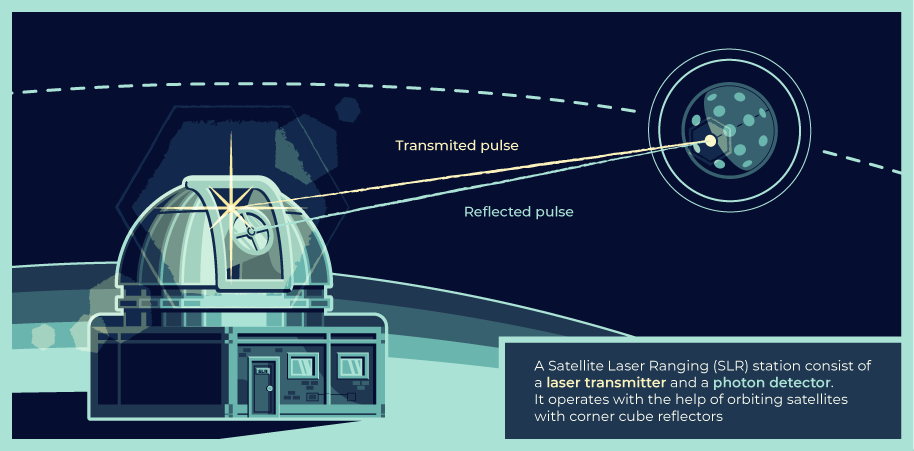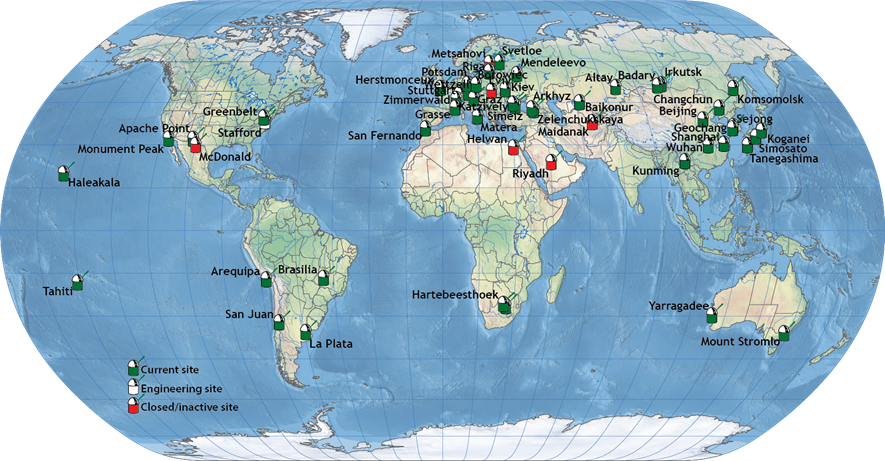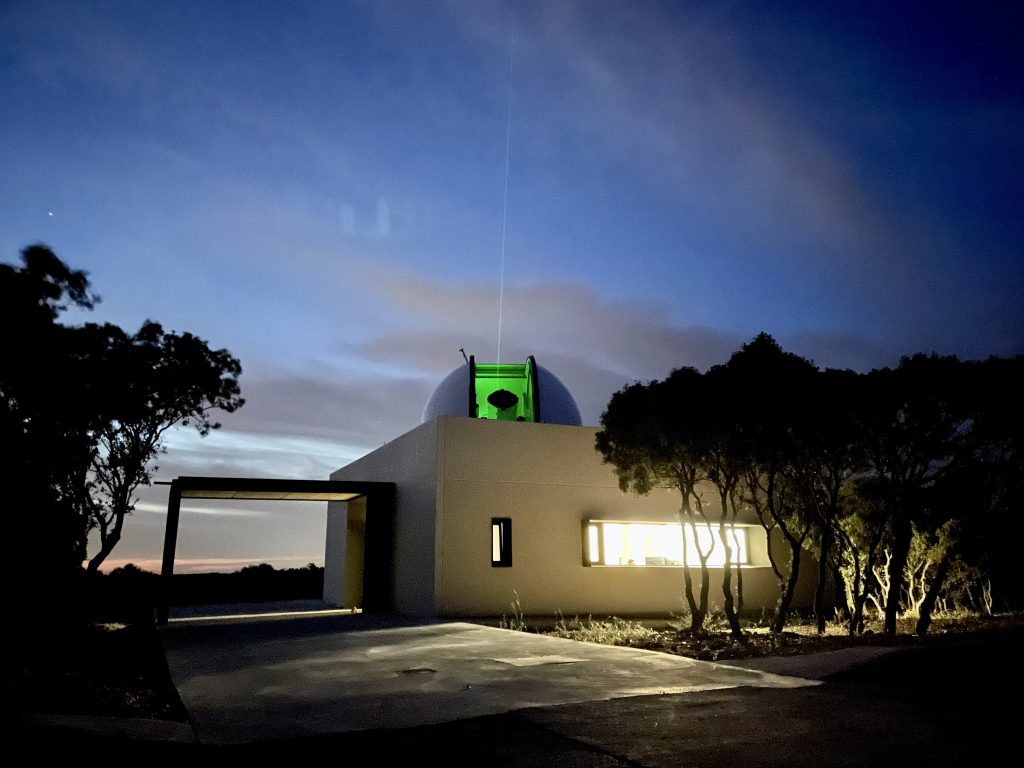SLR - SATELLITE LASER RANGING
SLR (Satellite Laser Ranging) is one of four space geodetic techniques, together with VLBI, GNSS and DORIS, that combined are employed to realize the global terrestrial reference frames.
The current SLR network comprises over 40 tracking stations globally distributed and run by scientific institutions from different countries. The SLR network provides very accurate distance measurements to various kinds of artificial satellites, from low Earth orbiting spacecraft with scientific payloads to communication satellites in geosynchronous orbits (i.e. from ~400 to ~40.000 km). In addition, lunar capable stations routinely perform laser ranging measurements to retroreflectors located on the surface of the Moon (LLR – Lunar Laser Ranging).
Some examples of SLR specific data products are:
- Coordinates of the Earth’s centre of mass;
- Scale of the terrestrial reference frame together with VLBI;
- Low-degree terms of the Earth’s gravity field;
- Realization of the global reference frame with station positions and Earth Rotation Parameters (ERP);
- Precise orbit parameters of satellites observed.
- SLR activities are coordinated by the ILRS (International Laser Ranging Service), one of the space geodetic services of the International Association of Geodesy (IAG), and a member of the IAG’s GGOS (Global Geodetic Observing System). The role of the ILRS consist in providing the required geodetic infrastructure for monitoring global change in the Earth system using SLR derived products.
SLR activities are coordinated by the ILRS (International Laser Ranging Service), one of the space geodetic services of the International Association of Geodesy (IAG), and a member of the IAG’s GGOS (Global Geodetic Observing System). The role of the ILRS consist in providing the required geodetic infrastructure for monitoring global change in the Earth system using SLR derived products.
WORKING PRINCIPLE
The working principle of the SLR technique is quite simple. Short pulses of laser light are emitted from a ground station through a transmitting telescope that is driven to follow the predicted position of an orbiting satellite, with the time of emission recorded by a timing device that is accurate and precise to several picoseconds. Laser pulses reach the retroreflectors mounted onboard the satellite and are directed back towards the receiving telescope located at the same ground station. Upon receipt of the reflected laser light, a high-speed detector generates an electronic signal that triggers the timer, thus recording the round-trip time-of-flight.
Half this time-of-flight multiplied by the speed of light, plus some small corrections, gives the distance to the satellite at the emission time of the laser pulse. Repeated measurements to the satellites from the whole network provide very accurate orbital information and the possibility to estimate other parameters of geodetic interest, such as station positions.

NETWORK
Currently there are over 40 tracking stations active (shown in Figure 2), although the total number of sites that have contributed laser ranging data is much greater. A weakness of the network is its poor geographical distribution, with the bulk of the stations located in the northern hemisphere. This translates into a sub-optimal tracking coverage with wide data gaps, impacting the quality of the geophysical parameters of interest derived from SLR measurements. It is expected that various new planned stations to become operation in the near future to make a positive contribution in this respect.

[Ref.] Image by ILRS
GROUND SEGMENT
The ground segment of SLR is formed by several groups and instruments, namely:
- Laser system: the general requirement is a pulsed laser of sufficient power to reach the satellites of interest, whose pulse length must be as short as possible to minimize uncertainty in the measurement. Most laser systems used currently at the SLR stations have the following features:
- Solid state pulsed lasers
- Nd: YAG (1064/532 nm)
- Repetition rates between 10 and 2000 Hz
- Pulse width 7-100 pico-seconds
- Energy from 0,3 to 180 mJ
- Telescope assembly: computer-controlled mounts are required to direct the laser pulses accurately towards the targets and receive the reflected photons on their return. The optic system is used to transmit and receive the laser pulses, two configurations can be found:
- Monostatic systems: just one telescope for laser pulse transmitting and receiving
- Bistatic systems: two dedicated optical systems, one for transmitting and a different one for receiving
- Telescopes capable of following the lowest satellites (400km) must track at speeds of up to 2°/s while maintaining an absolute pointing accuracy of a few arcseconds
- Dome: to protect the telescope and associated equipment. The best designs minimize direct sunlight exposure during daylight observations.
- Photo detectors that respond to the incoming light pulse and produce and electrical signal that stops the time measurement.
- Spectral filters to reduce noise during daylight observations.
- Spatial filter, iris: field of view limit.
- The range gate generator is used to reduce the noise level by activating the detector only a short instant before the predicted time of arrival of the laser pulses from the satellites.
- Time and frequency systems:
- Event Timer, device that performs the time-of-flight measurements with a few pico-seconds resolution
- Timing synchronization via GNSS
- Hydrogen Maser, frequency standard
- Station control system and monitoring
- Laser safety system: firing high-powered laser beams from ground level to space entails some safety risks that are addressed in multiple, redundant ways at the stations to ensure safe operations at all times.

APPLICATIONS
SLR data is used for several purposes, from the most theoretical aspects, such as in general relativity testing, to more practical ones, such as in orbit validation studies for satellite missions equipped with their own navigation systems. The most notable applications of SLR include:
- Terrestrial Reference Frames (TRF): The SLR technique is critically important in two major areas of the definition and maintenance of the reference frame: its scale and origin. The latter is uniquely determined by SLR observations (geocenter), and the former is given by the combination of VLBI and SLR
- Support of Scientific Missions: Trough verification and calibration of the orbits determined with other techniques (GNSS and DORIS) as well as through the inclusion of SLR observations in the orbit dynamics computations
- Tracking of GNSS constellations for orbit validation and dynamic model improvement.
- Space Debris: Laser ranging stations can be adapted to conduct observations to uncooperative targets or defunct satellites orbiting the Earth, by installing more powerful lasers.
- Lunar Laser Ranging: obtaining lunar physics parameters (ephemerides, rotation, tidal displacements, etc).
- Time Transfer: comparing clocks located in remote locations through intercontinental links via laser (e.g., T2L2)
- Earth gravity field: low-degree terms of the static and time-varying gravity field, mass motions within the solid Earth, oceans, and atmosphere.
- Geodynamic: tectonic plate motion and crustal deformation.
FINAL REMARKS
Understanding the processes that drive global change in the Earth system is a requirement for modern societies in order to adopt informed policy decisions to minimize the negative impact those changes may exert, to adapt in the long term to the environmental realities of a changing planet, and to plan and coordinate in advance prevention strategies and sustainable development models to ensure the well-being of future generations, at both national and international levels. Geodesy is the discipline that at a fundamental level underpins the scientific efforts aimed at gaining that understanding.
SLR is and will remain a key technology for these continuing endeavors. Increasingly stringent requirements in terms of precision, accuracy, and stability mean that constant improvements must be realized in the observing networks of the various techniques involved, the data processing strategies, and models employed in the data analysis. To this end many stations of the laser ranging network are upgrading their systems, and new sites are either under construction or at the planning stage. In addition, base technologies upon which key components of SLR systems rely continue to evolve, driving improvements in the technique and enabling new applications.
With the latest significant modernization of the hardware taking place in the late 2000s, the main aim for SLR in the present time and in the near future is the quest for ultimate performance reaching the global goal of 1 mm level accuracy.
[Ref.] Combrinck, L. “Satellite laser ranging”. In Sciences of Geodesy – I: Advances and Future Directions. Xu, G. ed. Springer Berlin Heidelberg, Berlin, 2010. ISBN: 978-3-642-11741-1.
[Ref.] Rodríguez, José C., and Graham M. Appleby. “Satellite Laser Ranging.” Handbook of Laser Technology and Applications. CRC Press, 2021. 181-198.
[Ref.] Seeber, G. Satellite Geodesy: Foundations, Methods, and Applications. 2nd ed. (Walter de Gruyter, Berlin, New York, 2003. ISBN: 3-11-017549-5.
